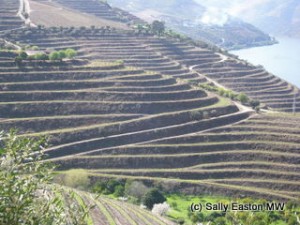Douro grapes – lessons for climate change?
 Portugal’s Douro valley is a complex, extreme, mountainous vineyard region; and it’s hot. Given the region’s long viticultural history, the vines tend to be well adapted to the extreme conditions. Vines are planted at river level, from around 100m above sea level, to above 500m up the slopes. Vineyard aspects cover the full 360°. In wine terms, these guys are at the vanguard of how to deal with a warming world.
Portugal’s Douro valley is a complex, extreme, mountainous vineyard region; and it’s hot. Given the region’s long viticultural history, the vines tend to be well adapted to the extreme conditions. Vines are planted at river level, from around 100m above sea level, to above 500m up the slopes. Vineyard aspects cover the full 360°. In wine terms, these guys are at the vanguard of how to deal with a warming world.
And the development of still Douro wine in the traditional Port wine district has opened up new understanding of the grapes, their adaptations and favoured locations. Rui Cunha of Secret Spot wines said “we are learning to look at the grapes differently for port and table wine. For table wine, we don’t want to produce over-matured red wines. So we are looking at the grape varieties, at the slopes, and we are looking up 400, 500m to produce elegant [still] wines.”
The main red grape varieties in the Douro Valley
| Grape variety | Percentage of Douro production |
| Touriga franca (formerly known as touriga francesca) | 23 |
| Tinta Roriz (aka tempranillo) | 16 |
| Tourgia nacional | 13 |
| Tinta barroca | 12 |
| Tinta amarela (aka trincadeira) | 3 |
| Sousão | 1 |
| Cão | <1 |
Source: IVDP, 2011.
Touriga franca
This is the offspring of touriga nacional and mourisco, the two main grape varieties before phylloxera, at the end of the 19th century. It tolerates heat and water stress well, and doesn’t produce too much sugar when ripe, so it’s good for hotter locations. Luis Seabra, the winemaker at Niepoort’s Quinta de Nápoles said “in cold places people don’t like it because it ripens slowly. It is an elegant variety, but not easy.” Antonio Magalhães, the viticulturist at the Fladgate Partnership added “it is a grape variety for organic [cultivation] because it has a high tolerance to disease.”
Tinta roriz
Despite making the second largest contribution to Douro production, there are questions about the suitability of tinta roriz, or tempranillo, to the hot climate of the Douro. “It doesn’t really like the heat, and it loses acidity a lot” said Cunha. It’s best suited to cooler sites high up on north-facing slopes. Managing director Paul Symington at Symington Family Estates said “we haven’t planted any tinta roriz because we believe we have the wrong clones. It lacks elegance, depth, structure” for port.
Touriga nacional
A variety that is growing in popularity, but 80 years ago it was not widely planted in the Douro. Tiago Alves de Sousa of Quinta da Gaivosa said “touriga nacional was not popular in the past because it’s a low producer. But in the most recent plantings, more and more is planted.” It still accounts for only 13% of production, and it’s only since the 1970s and 1980s that it has been revitalised to its current position.
Touriga nacional’s great asset is its ability to ripen in great heat and keep its acidity, though it ripens earlier than touriga franca, and, said Pedro Tamagnini of Quinta dos Avidagos, “nacional is an overwhelming grape, it can dominate a blend.” Nonetheless, José Manso, the viticulturalist at Quinta de São Luis said “we calculate touriga nacional is 2,000 years old, with about 400 clones” so it’s had time to adapt to the climate.
Tinta barroca
This may be the grape growers’ favourite variety. Manso said “it’s a homogenous grape variety. It’s easy to cultivate.” It has high sugar content, which along with its structure and body make it good for port wine. But with too little colour, it’s less well regarded for still wine. Symington said “It’s not glamorous, but a port without barroca lacks structure and depth, a bit like merlot in Bordeaux.”
Tinta amarela
There may be a west-east split on amarela. In the western Baixo Corgo, Alves de Sousa said the variety “can reach high sugar levels but it holds acidity well, and it’s complex in terms of flavour.” But it’s not adapted to the Douro Superior, near the border with Spain, Pedro Barbosa, the viticulturalist at Quinta do Vale Meão, said “amarela gets burnt on south facing slopes, and on north facing slopes, you get green grapes with 8° alcohol. It’s completely unbalanced.”
Tinta cão
The ‘red dog’. Alves de Sousa said he blends tinta cão, with its “mineral, fresh, nice acidity, to civilise a bit the touriga national, which is a great grape but can be over the top with richness and exuberance.” And Magalhães said cão is the grape variety for climate change with “high tolerance to drought and sunburn” but it’s not usually more than a few percent in the finished blend.
And it’s all about the blend, for both port wine and still wine: grapes, locations, altitudes, aspects.
My research visit to the Douro was sponsored by the ‘Discover the Origin’ campaign.



